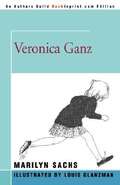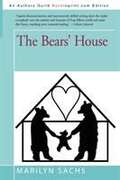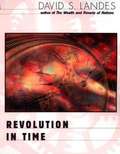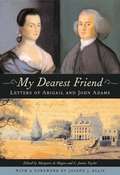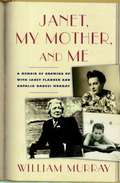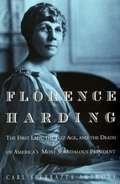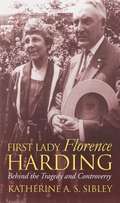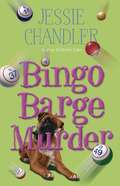- Table View
- List View
Veronica Ganz
by Marilyn SachsFirst published in 1968. One of the most famous bullies in children's books, Veronica Ganz has never met her match. She has systematically beaten up everybody in all of the classes, and has never been challenged until ... until little Peter Wedemeyer moves into the neighborhood. Taunting, teasing and always one step ahead of her mighty fists, Veronica must find a way to teach him who is boss.
The Bears' House
by Marilyn SachsFirst published in 1971. Everyone in Miss Thompsons fourth grade class loves The Bears’ House—Fran Ellen Smith most of all. When Fran Ellen goes into The Bears’ House, she can forget about how awful things are at home. At the end of the term Miss Thompson is giving the house away to someone in the class. Fran Ellen knows it won’t be her. How is she going to get along without a place to hide?
Play Ball, McGill!
by Amelia WaldenWhen things begin to go wrong at home and in her social life, the star pitcher of the high school softball team feels her game being affected also. Ginger McGill's senior year becomes a mix of emotions with her love for softball, her baseball star brother, rebuilding hot rods and a new boy in town.
Skateboard Scramble
by Barbara DouglassAlthough she loves skateboarding, Jody is uneasy when her father insists that she participate in a skateboard competition, especially as she would be competing against her best friend.
Listen for the Fig Tree
by Sharon Bell MathisA sixteen-year-old girl's first celebration of Kwanza gives her a sense of the past as well as strength to deal with her troubled mother and her own blindness.
Run / Ride
by Kip CrosbyMotorcycles are a common theme in this novel of a group of young people dealing with many difficulties.
Keeping Watch: A History Of American Time
by Michael O'MalleyA history of the transition from natural to mechanical sources for time, Keeping Watch explores the invention of Standard Time Zones and daylight saving as well as the mass production of watches and clocks.
The Danish Girl: A Novel
by David EbershoffAuthor's Note: This is a work of fiction loosely inspired by the case of Einar Wegener and his wife. I wrote the novel in order to explore the intimate space that defined their unusual marriage, and that space could only come to life through conjecture and speculation and the running of imagination. Some important facts about Einar's actual transformation lie in these pages, but the story, as recounted here with its details of place and time and language and interior life, is an invention of my imagination. In early 1931 when the news broke that a man had changed his gender, newspapers around the world ran accounts of Einar Wegener's remarkable life. (It is interesting to note that Lili Elbe herself leaked the story to the press, and wrote some stories about herself, including her own obituary, under a pseudonym.) Many of those articles were helpful in writing this novel, especially those in Politiken and other Danish newspapers. Another indispensable source was Lili Elbe's diaries and correspondence, which Niels Hoyer edited and published as Man Into Woman. Those journal entries and letters provided critical factual details of Einar's evolution, especially regarding Lili's first visit to Wegener's studio, Einar's mysterious bleeding and physical decline, and his journey to and stay at the Dresden Municipal Women's Clinic. The passages in my book that deal with these incidents are especially indebted to Hoyer's assemblage of Lili Elbe's original words. Nonetheless, I have changed so many elements of Einar Wegener's story that the characters in these pages are entirely fictional. The reader should not look to this novel for very many biographical details of Einar Wegener's life, and no other character in the novel has any relation to an actual person, living or dead.
Matters of Principle: An Insider's Account of America's Rejection of Robert Bork's Nomination to the Supreme Court
by Mark GitensteinDetails the rejection of Robert Bork's nomination to the Supreme Court and the fight to protect unenumerated rights.
Revolution in Time: Clocks and the Making of the Modern World (Revised and Enlarged Edition)
by David S. LandesMore than a decade after the publication of his dazzling book on the cultural, technological, and manufacturing aspects of measuring time and making clocks, David Landes has significantly expanded Revolution in Time. In a new preface and scores of updated passages, he explores new findings about medieval and early-modern time keeping, as well as contemporary hi-tech uses of the watch as mini-computer, cellular phone, and even radio receiver or television screen. While commenting on the latest research, Landes never loses his focus on the historical meaning of time and its many perceptions and uses, questions that go beyond history, that involve philosophers and possibly, theologians and literary folk as well.
My Dearest Friend: Letters of Abigail and John Adams
by Margaret A. Hogan C. James Taylor(from Forward: J. Ellis)My two favorite Sceanes of John and Abigail Adams come from their retirement years at Quincy. In the first John is out in the fields working alongside his hired hands, swinging the scythe as he murmurs curses under his breath against Tom Paine and Alexander Hamilton. Abigail is duly recording his murmurings, seconding his denunciations, noting that Thomas Jefferson should also be added to the rogues' gallery. In the second scene, Abigail has descended to the basement of the Quincy house to shell peas. John accompanies her, bringing along a copy of Descartes to read to her while she prepares dinner. It is the combination of pungency and intimacy embodied in these two Sceanes that gives the correspondence between John and Abigail such enduring significance, though a few other factors contribute to the ultimate impact. They happened to be living through the most tumultuous and consequential chapter in America's birth as a nation, when the core values were declared and the abiding institutions created. They happened to be centrally involved in these declarations and creations. They happened to preserve about 1,160 letters between them, recording their thoughts and feelings with uncommon candor. (Martha Washington destroyed all but three of the letters she and George exchanged.) And both of them happened to be, each in their own distinctive ways, prose stylists of equally uncommon felicity. If you want to understand how the American republic was improvised on the run, this is a seminal source. If you want to understand how a husband and wife can sustain their love over a lifetime of struggle and
Family Values: Two Moms and their Son
by Phyllis BurkeA beautifully written memoir of the author's fight to legally co-parent her lesbian lover's child--an inspiring story of love, liberation, and family values. Set against the background of the San Francisco lesbian-gay civil rights struggle, Burke's uplifting portrait of her nontraditional family will deeply touch readers.
Janet, My Mother, and Me: A Memoir of Growing Up With Janet Flanner and Natalia Danesi Murray
by Williamson MurrayJanet, My Mother, and Me is a charming, captivating memoir about a boy growing up in a household of two extraordinary women. William Murray was devoted to his mother, Natalia Danesi Murray, and to his mother's longtime lover, writer Janet Flanner. Even as a teenager, he accepted their unconventional relationship. His portrait of the two most important people in his life is unforgettable. Janet Flanner was already celebrated as the author of a new style of personal journalism for her "Letter from Paris" in The New Yorker when she met the Italian-born Natalia Murray on Fire Island, New York, in 1940. Their encounter, writes William Murray, was a "coup de foudre, a thunderbolt that instantly sent them rushing into each other's arms and forever altered their lives, as well as mine." Murray was already growing up in two cultures on different continents, in New York and Rome, when his mother's life changed so dramatically. He quickly accepted Flanner and the unusual household in which he found himself. (Natalia's mother, Mammina Ester, also lived with them in New York.) His memories of the women and of his own boyhood and adolescence are touching and often hilarious. Janet, My Mother, and Me offers a look at the world in which gay professional women moved in the decades before such relationships became more open and accepted. Murray's mother was a publishing executive and a broadcaster, and Murray, who originally hoped to become an opera singer and trained for that profession, eventually moved into the professions of both his mother and Flanner, becoming a novelist and then for many years an editor and writer at The New Yorker. This is an exuberant, warm, and often poignant memoir with a memorable cast of characters. Beguiling and unusual, it will remain vivid in readers' minds for years to come.
Florence Harding: The First Lady, the Jazz Age and the Death of America's Most Scandalous President
by Carl Sferrazza AnthonyTells the story of Florence Harding's rise from young unwed mother to First Lady and reveals her influence behind Harding's ascent to America's most scandal-ridden presidency and her role in his death. The drama of her life is set against the stage of the White House in the Jazz Age, and involves exciting elements such as mistresses, blackmail, poisoning, and opium addicts.
Election Journal: The Political Events of 1987-1988
by Elizabeth DrewThe Presidential election of 1988 changed Presidential politics, in ways that will be with us for a long time. New techniques, ans a new tone, were employed, and since they were successful, they are likely to be emulated throughout our political system.
The Dialectic Of Sex: The Case For Feminist Revolution
by Shulamith FirestoneA best-seller upon its original publication in 1970--when Shulamith Firestone was just twenty-five years old--The Dialectic of Sex was the first book of the women's liberation movement to put forth a feminist theory of politics. Beginning with a look at the radical grassroots history of the first wave of feminism and its foundation in the abolition movement, Firestone documents its major victory, the granting of the vote to women in 1920, and the fifty-year backlash that followed. Deftly synthesizing the work of Freud, Marx, de Beauvoir, and Engels, Firestone creates a powerful argument for feminist revolution in which she asserts that women must seize the means of reproduction. For as long as women (and only women) are required to bear and rear children, they will lack the biological and attendant economic independence required to be completely liberated. Ultimately, she presents feminism as the key radical ideology, the missing link between Marx and Freud, uniting their visions of the political and the personal. As revelatory and urgent as it was upon its first publication, The Dialectic of Sex is a testament to Shulamith Firestone's startlingly prescient vision. It remains required reading for anyone concerned about the history of feminism as well as the ongoing hurdles faced by women to this day in regard to motherhood, child care, and career.
The Pencil Families
by Susan TerrisAfter she discovers a dead body floating in the lagoon, ten-year-old Emily's life becomes even more exciting than the fantasies she creates for her "pencil families."
Step on a Crack
by Mary AndersonSarah suffers from frightening nightmares and compulsive stealing. A friend helps explore the dark areas of her mind, exposing some disturbing facts.
Three Knocks on the Wall
by Evelyn Sibley LampmanMarty had just finished burying a dead robin in her pet cemetery near the tall wooden wall that surrounded the Hutchinson yard and house next door. Suddenly she heard it--knock, knock, knock --three knocks coming from the other side of the wall. For a moment Marty was too petrified to move. Knocking on a wall was something a crazy person might do and some people said old Mrs. Hutchinson was crazy, living alone with an unmarried daughter and seeing no one. Then the knocks came again. Marty soon learned the identity of the person on the other side of the ten-foot wall, and why she stayed there. What was harder to discover was a way to help her new invisible friend. For a long time, all Marty could do was to communicate through the wall and be patient. It was not until a deadly flu epidemic gripped the town and Marty could not come to the wall that her friend finally dared to step outside it. Evoking small town life in Oregon during World War I with vividness and a clear sense of time and character, Evelyn Sibley Lampman has created a very human and dramatic story that will carry its readers along to a most satisfying conclusion.
Second-Wave Millennials: Tapping the Potential of America's Youth
by Warren WrightAuthor Warren Wright takes you on an engaging journey through the generations in the workplace, starting with “Dave” the Boomer, and ending with the newest kid on the block—“Samanthe”, a Second-Wave Millennial. Page-turning narrative peppered with practical solutions tells the compelling story of how different generations can get along in the workplace—with an emphasis on tapping the potential of the newest generation—Second-Wave Millennials. Second-Wave Millennials reveals: 5 ways to craft an ideal workplace for all generations 4 lifestyle themes that make up Millennials’ identity The top soft skills required for the newly-hired Second-WaveMillennials
First Lady Florence Harding: Behind the Tragedy and Controversy
by Katherine A. S. SibleyFlorence Kling Harding has come down through history as one of our most scorned first ladies. Victimized by caricatures and branded a shrew, she stands at the bottom of historians' polls, her reputation tarnished by her husband's scandals despite their joint popularity while in office. These depictions, argues Katherine Sibley, have prevented us today from seeing how innovative a first lady Florence Harding really was. This new look at Mrs. Harding restores humanity to an oft-maligned figure by examining her progressive causes, her celebrity, and her role in her husband's work. For if Eleanor Roosevelt is credited with shattering the first lady's ceremonial mold, it was Florence Harding who made the first cracks. Sibley's is the first book to offer a full treatment of Florence as first lady rather than as mere supporting actress in the Harding administration. Never shying from publicity, she made herself more available to the press than did her predecessors and opened the White House up to the public. And she took such a pioneering role in Warren Harding's campaign and presidency that many thought she outdid her husband as a politician. Turning to primary sources that others have overlooked, Sibley challenges the clichés about Florence's time in the national spotlight. She describes how Mrs. Harding supported racial equality, lobbied for better treatment for veterans and female prisoners, and maintained a lifelong interest in preventing animal cruelty. As adviser to her husband, she assisted with his speechwriting and consulted with the cabinet; she was also the first first lady to deliver spontaneous speeches while traveling with the president. At a personal level, Sibley examines in detail how Mrs. Harding responded to her husband's death, assessing why this tragedy struck Americans with such force even as national empathy proved so fleeting. She also offers a more nuanced description of the president's philandering, viewing Nan Britton's claims with skepticism while noting the effects on Florence of his dalliance with Carrie Phillips. Florence Harding bequeathed an activist legacy, and it is due to her example that aspiring presidential wives are expected to campaign with their husbands and be accessible to public and press. Florence Harding truly set the stage for those to follow; this book delivers the full and fair portrait that has long been her due.
Not a Passing Phase: Reclaiming Lesbians in History, 1840-1985
by Lesbian History GroupA collection of essays and articles about "romantic friendships" between famous women of the past.
Bingo Barge Murder (Shay O'Hanlon Caper #1)
by Jessie ChandlerAs co-owner of The Rabbit Hole, a quirky-cool Minneapolis coffee shop, Shay O'Hanlon finds life highly caffeinated but far from dangerous. That is, until her lifelong friend Coop becomes a murder suspect. The victim was Kinky, Coop's former boss and the unsavory owner of The Bingo Barge, a sleazy gambling boat on the Mississippi. The weapon? Kinky's lucky bronzed bingo marker. While unearthing clues to absolve Coop, Shay encounters Mafia goons hunting for some extremely valuable nuts. Looking for the murderer without help from the cops proves risky-especially with distracting sparks flying between Shay and the beautiful yet fierce Detective Bordeaux. When Shay's elderly friend and landlady is held for ransom by the mob, all bets are off. Can Shay find the killer before the stakes get any higher?
Hide and Snake Murder (Shay O'Hanlon #2)
by Jessie ChandlerBook two in the riotous caper series starring Shay O'Hanlon and her trouble-prone pals. When Shay O'Hanlon's ill-mannered friend Baz steals a stuffed snake from a wealthy businessman, he wasn't expecting it to be filled with money. Nor was he expecting his aunt Agnes to take it with her on vacation to the Big Easy. With trigger-happy thugs in hot pursuit, Shay leads her friends on a rowdy rescue mission from Minneapolis to New Orleans and back. Along the way, a bungled burglary puts the gang in a drug cartel's cross hairs, and a beautiful professor offers the only way out. But can Shay and the gang trust her with their lives?
Louise Brooks
by Barry ParisLouise Brooks left Wichita, Kansas, for New York City at age fifteen and lived the kind of life of which legends are made. From her beginnings as a dancer to her years in Hollywood, Berlin, and beyond, she was hailed and reviled as a new type of woman: independent, intellectually daring, and sexually free. In this widely acclaimed, first and only comprehensive biography, Barry Paris traces Brooks's trajectory from her childhood through her fall into obscurity and subsequent "resurrection" as a brilliant writer and enduring film icon.
